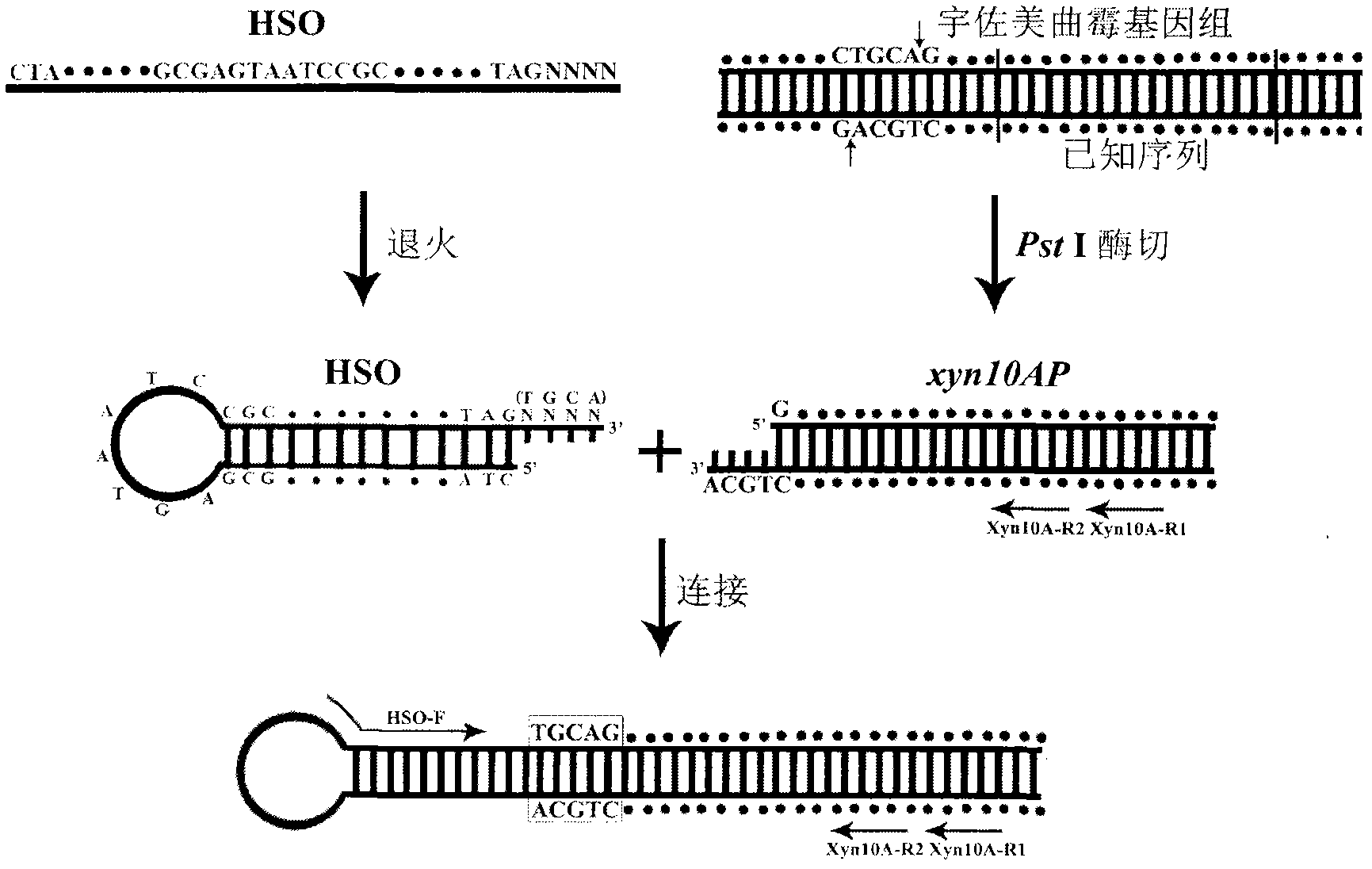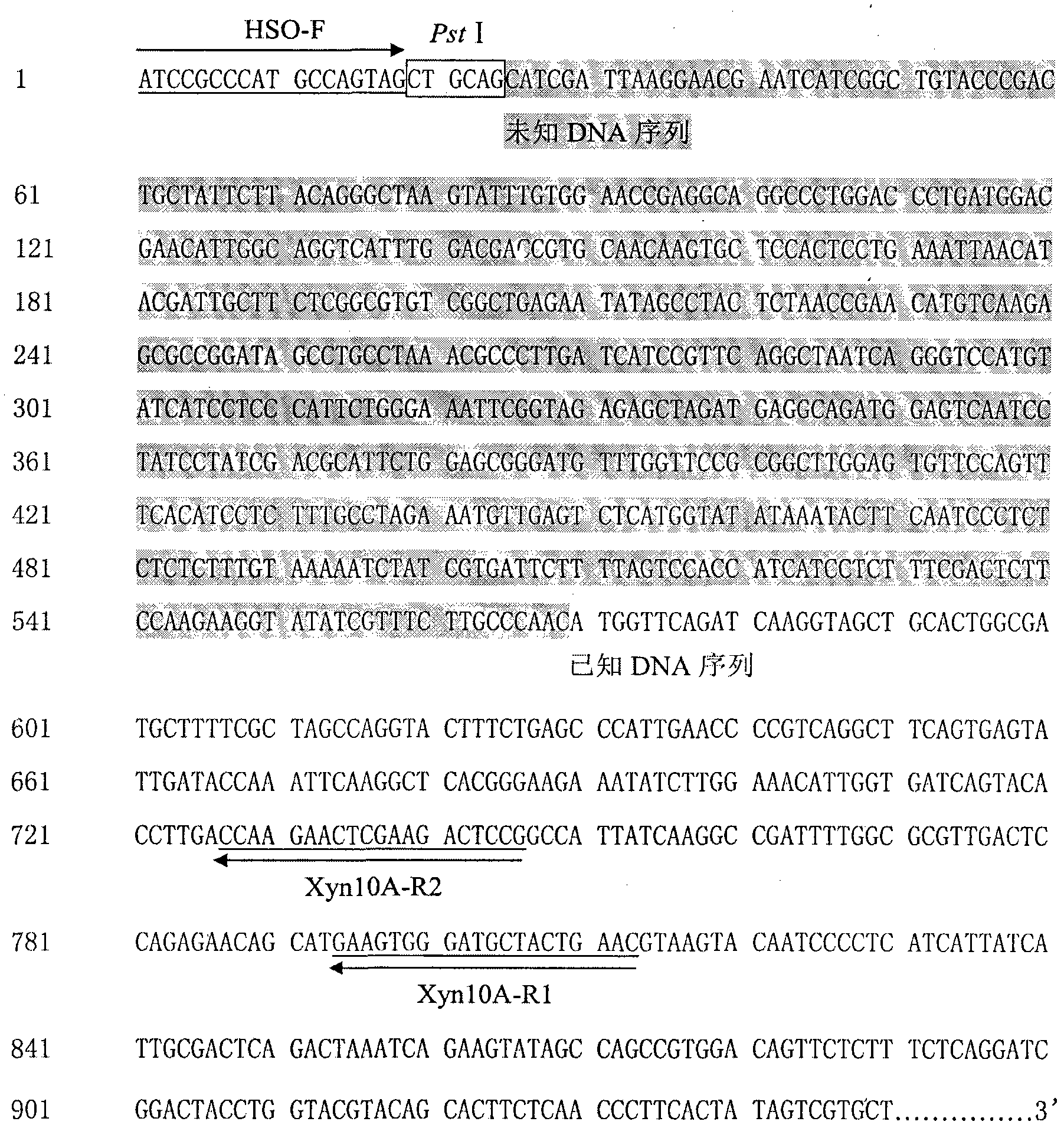Method for determining 5' end flank unknown sequence by using hairpin structure mediation
A technology of hairpin structure and unknown sequence, applied in the field of bioengineering, can solve the problems of inability to determine the sequence of upstream and downstream regulatory elements, unstable mRNA, unsatisfactory effect, etc., and achieve the effect of saving labor, low cost, and less operation restrictions
- Summary
- Abstract
- Description
- Claims
- Application Information
AI Technical Summary
Problems solved by technology
Method used
Image
Examples
Embodiment 1
[0029] Determination of the Aspergillus usamii E001 xyn10A promoter sequence.
[0030] (1) Preparation of DNA digestion products: PstI was selected for single digestion of Aspergillus usami genomic DNA. The following enzyme digestion system was constructed: 10×H Buffer 2 μl, PstI 2 μl, genomic DNA 10 μl, sterile water 6 μl; the above system was reacted in a 37°C water bath for 4 hours. The purified product (20 μl) was named xyn10AP.
[0031] (2) Preparation of the hairpin structure: HSO (100 μmol / L) 2 μl, sterile water 8 μl, mix well; denature at 94°C for 3 minutes, slowly cool down (1°C / s) to 25°C and then anneal at constant temperature for 30 minutes.
[0032] (3) Ligation of xyn10AP and hairpin structure: 1ul of 10×T4 DNA Ligase Buffer, 3 μl of HSO, 5 μl of xyn10AP, 1 μl of T4 DNA Ligase; overnight at 16°C.
[0033] (4) The first round of PCR amplification of xyn10A promoter: 10×PCR Buffer 2.5 μl, dNTP 1.5 μl, HSO linker 2 μl, HSO-F 0.5 μl, Xyn10A-R1 0.5 μl, sterile water...
Embodiment 2
[0037]Determination of the Aspergillus usamii E001 xyn11A promoter sequence.
[0038] (1) Preparation of DNA digested products: MspI was used to digest the genomic DNA of Aspergillus usami. The following enzyme digestion system was constructed: 2 μl of 10×T Buffer, 2 μl of MspI, 2 μl of 0.1% BSA, 10 μl of genomic DNA, and 4 μl of sterile water; the system was reacted in a water bath at 37°C for 4 hours. The purified product (20 μl) was named xyn11AP.
[0039] (2) Preparation of hairpin joints: HSO (100 μmol / L) 2 μl, sterile water 8 μl, mix well; denature at 94°C for 3 minutes, slowly cool down (1°C / s) to 25°C and anneal at constant temperature for 30 minutes.
[0040] (3) Ligation of xyn11AP and hairpin structure: 1 μl of 10×T4 DNA Ligase Buffer, 3 μl of HSO, 5 μl of xyn11AP, 1 μl of T4 DNA Ligase; overnight at 16°C.
[0041] (4) The first round of PCR amplification of xyn11A promoter: 10×PCR Buffer 2.5 μl, dNTP 1.5 μl, HSO linker 2 μl, HSO-F 0.5 μl, Xyn11A-R1 0.5 μl, steril...
PUM
 Login to View More
Login to View More Abstract
Description
Claims
Application Information
 Login to View More
Login to View More - R&D
- Intellectual Property
- Life Sciences
- Materials
- Tech Scout
- Unparalleled Data Quality
- Higher Quality Content
- 60% Fewer Hallucinations
Browse by: Latest US Patents, China's latest patents, Technical Efficacy Thesaurus, Application Domain, Technology Topic, Popular Technical Reports.
© 2025 PatSnap. All rights reserved.Legal|Privacy policy|Modern Slavery Act Transparency Statement|Sitemap|About US| Contact US: help@patsnap.com



